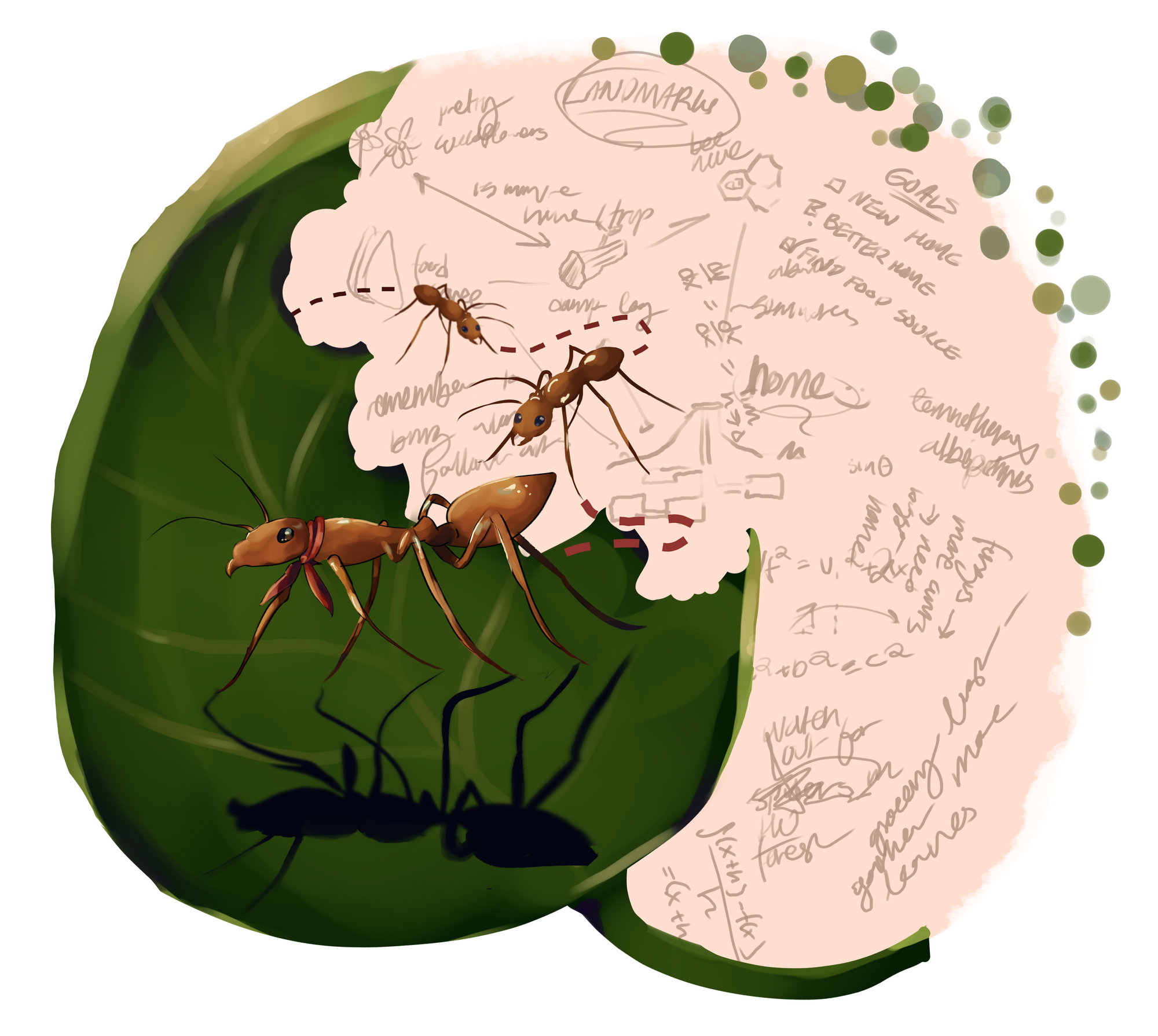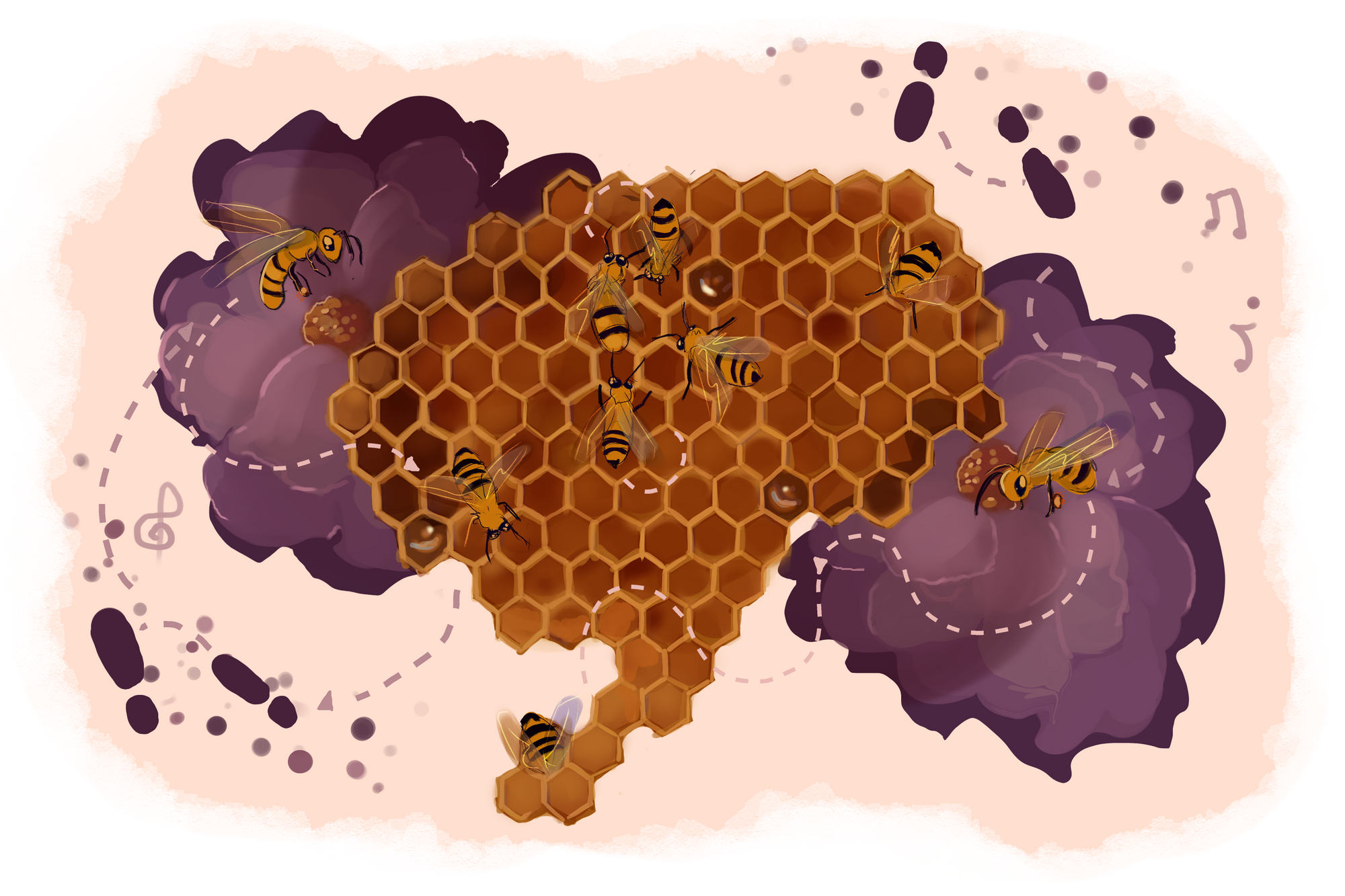Introduction
When you were younger, did you ever sit and watch the movement of a beehive or anthill? It’s like watching the ocean’s currents or leaves floating in the wind. But in insect colonies, the motion is purposeful, every little movement adding up to the rhythmic motion of the whole. There doesn't seem to be any clear organization, but out of the chaos emerges efficient decision making, which is known as collective cognition. Groups of insects can build complex architectural structures, efficiently hunt for food over large areas and pick the best location for a nest out of hundreds of options. So, how can insects with brains smaller than a grain of rice work together so seamlessly and make optimal decisions like we would expect from an organism with a far more complex brain? And to that point, if a group can have cognitive abilities that are so much greater than any of the individuals who make up the group, it becomes unclear whether the measurement of an individual’s cognitive ability should be based on their inherent abilities or their abilities in a group. It raises the question, when does cognitive ability become a quality of a group rather than an individual? While this phenomenon is studied in social insects, it has implications for our general understanding of cognitive ability and could change the way we think about intelligence in humans.
Examples
Scientists who study this phenomenon of collective cognition of bees and ants have classified them as part of a group known as social insects, who form large and highly organized groups that can divide labor among individuals [1]. To understand how these social insects can access cognitive abilities far greater than their own, we must first understand how any group of animals makes collective decisions. A well-studied example of this mechanism can be seen in migrating birds. Flocks of migrating birds generally don't have the same hierarchical structure we see in many mammal communities, where control is centralized to specific individuals. Instead, decision-making is dispersed among all individuals in the group. A few birds will sense an external stimulus like a predator, and change their behavior in response to avoid the threat. Each bird mirrors the behavior of the other birds directly next to them, so a wave of behavioral change ripples across the entire group as each animal reacts to the one next to them. This allows the group to use the combined information from every individual in order to make better-informed decisions. An individual on one side of the group can react to a stimuli on the other side without that information ever reaching a leader. This reduces response time, as information no longer needs to make its way up to a leader and then back down to each member. By cutting out that time for information transmission, birds are able to rapidly change the entire group’s behavior in response to a threat. Because the collective movement is built up of numerous local interactions between neighboring birds, it can occur without a more complex communication system like language. Birds can also use vocalizations to communicate general information, but local interactions allow them to make smaller and quicker adjustments. These adjustments combine to allow the whole flock to pick the best path to fly even if no single bird is aware of all the factors that went into the decision. But what happens when there’s a conflict of interest, when two groups of birds want to go in different directions? A study at the University of Oxford using Homing pigeons discovered that the final decision is based on the degree of difference between the two preferred directions. When the difference is small, the birds will travel in the average of the two directions. However, once the difference between the two directions reaches a specific threshold, the birds will switch to a “winner-takes-all” model, which means that the whole group will fly in one direction, although it is not yet understood how the flock decides between the two [2].
In bird flocks, individuals in a group move in unison, and travel right next to each other so communication is fairly simple. However, in social insect colonies, each individual can move in an independent direction and carry out separate tasks. Information needs to be conveyed between insects who are doing separate tasks, meaning they won’t always be close enough to communicate directly [3]. Because of these limitations, collective decision-making in social insects requires different methods of communication, but it allows colonies to distribute information processing across the entire group, making the whole colony more efficient in ways not seen in migrating birds. One easily observable example of this is foraging behavior, when a community of social insects must make a decision on which areas are best for gathering food or building a nest. Social insect species have evolved a number of different mechanisms to utilize their population size, increasing both efficiency and accuracy. Studying these examples can reveal fascinating insights into the mechanisms of collective cognition.
One of the most extensively studied social insects is ants, who have evolved a system of coordinating foraging behaviors by modifying their environment with varying amounts of chemical pheromone trails. As ants called scouts explore a pathway to gather food, they release trail pheromones, which stick to the ground. These pheromones assist ant colonies in determining which food source is closest and therefore most efficient. Over time, the shorter pathways will have the most trail pheromones because the ants can travel that pathway faster, laying more pheromones each time. Ants are also more likely to follow pathways with a higher concentration of trail pheromones, and subsequently, ants will release more pheromones as they walk the pathways, making heavily trafficked pathways (i.e. pathways that more consistently lead to food) become more concentrated with pheromones. This exponentially increases the pheromones on shorter paths, allowing the colony to choose the most efficient path to forage [4].

Ants also display collective decision-making when “house-hunting,” the process of finding and deciding on a site for a new nest. One species of ant, Temnothorax Albipennis, is a particularly interesting example of this process because their colonies move often and are too small to rely on the trail pheromones we see in larger ant colonies [5]. Instead, when the colony needs to move, around a third of the colony is sent out as scouts. Once a scout has determined a site to be adequate based on a number of qualities like light and space, they return to the original nest and find another ant, called a follower ant, to lead along the route to the new site [3]. This process is called a tandem run. Researchers at the University of York studied this process by blinding follower ants with paint and comparing them with follower ants that weren’t visually impaired. They found that the ants who were blinded traveled much faster than the control group. From this result, the researchers concluded that the follower ants learn visual landmarks during the runs that allow them to navigate the path on their own [6]. Once the second ant reaches the new site it will perform its own evaluation and if it also deems it adequate, it will become a second recruiter, returning with the first ant to pick up two more ants. Over time, more and more ants will be recruited to the new nest, and since the chance that a scout will recruit another ant is based on site quality, better sites will have more ants [3]. While this process is quite effective in accurately determining the best site between a number of options, it’s very slow. Leading ants one by one to a site the whole time would take far too long, and many insects would go to the subpar sites, even after the (decision had been made.) To increase efficiency, ants use what is called quorum sensing. When a scout senses a certain (threshold of population density) at the new site, they will start physically grabbing other ants and carrying them to the new site, which is much faster than leading them [7]. The colony assumes that once a certain number of individuals have been recruited to a site, it is a safe option to commit to sacrificing a small amount of accuracy for speed.
The Temnothorax Albipennis colonies often move because their current sites get damaged or destroyed, but they will also move if they find a significantly better site. Researchers at the University of Bristol wanted to see if this was simply the ants comparing novel options, and the moving could be triggered by another factor, or if the colony was actually comparing each new option to their current site. Their study found that ants who were currently in a good site wouldn't move to another good site. However, the ants would move to that same good site if their current site was mediocre. Because the final site was the same quality in both cases, we can infer that the ants are comparing their current site to the new option, and only moving once the new site is significantly better than their current site [8].
Most of the collective cognition involved in house hunting behavior is similar to that of foraging behavior. However, house hunting is particularly interesting to neuroscientists because it requires a colony-wide decision rather than just a preference for one pathway over the other. Additionally, scouts must individually assess the complex qualities of the site, and turn that into a binary decision about whether or not to recruit another ant. This is more complicated than foraging behavior where individual ants follow a randomly chosen path. During foraging the ants never actually respond to the choices, one pathway has more pheromones simply as a result of it being shorter and therefore quicker to traverse. The collective cognition involved with househunting is fascinating because it allows the ant colony to make large-scale decisions even when no individual insect ever makes a direct comparison of the options, or is even aware of the other options [7].
Another social insect that serves as a good example is honeybees. Honeybees and ants have fairly similar mechanisms for collective cognition, but their method of actually communicating the information from scouts to uninformed insects is different. Honeybees use a mechanism coined by popular science as the “waggle dance”, where the length of the dance is indicative of how good the site is. Other bees see the dancing and are recruited, creating a positive feedback loop at good sites [9].
General Mechanisms
So what do these mechanisms tell us about how cognitive ability is increased in communities of social insects? As discussed above, individual insects each have very limited information and cognitive ability, but when they’re in a group, they can make accurate and efficient decisions to ensure the survival of their colony. If instead one insect was designated as a leader and had to examine every foraging path or nest site and then compare them this mechanism would take much longer and be less accurate. Each foraging path or nest site would then only be examined by only one scout, compared to the repeated examination in social insect colonies. If colonies were to collectively follow the decisions based on one or even few scouting insects, the colony at large would be largely susceptible to individual mistakes or deficits, greatly decreasing the survivability of the entire colony. Insect colonies can utilize these repeated examinations as a way to ensure efficiency and accuracy in picking appropriate nesting and foraging locations by utilizing their large colony sizes. As an evaluation is made over and over, the average result becomes more accurate, a phenomenon known as the law of large numbers [10]. For collective cognition, this means that an individual making an error of judgment doesn’t have as much impact on the final decision because there are hundreds of other insects making the same evaluation, and as the number of evaluations increases the more accurate the final decision becomes.
If colonies relied on the decisions of individual insects instead of collective movement, each individual insect would also require an immense amount of cognitive ability compared to the abilities seen in bees and ants, as these scouting insects would need the ability to compare several sites on multiple variables and would therefore need a fairly significant working memory. By dispersing the process between a number of individuals, social insects can benefit from a greater cognitive ability without the need for a complex brain.

Implications
This phenomenon of collective cognition, decision-making responsibilities being spread across a group of animals, brings up some interesting questions about the nature of cognitive ability as a whole. Colonies of social insects have been called “super-organisms”, an idea that considers an entire colony as one collective mind. Generally we view cognitive ability as something that is inherent to an individual. However, if we define cognitive ability as the ability to solve problems, make decisions and learn from experiences, even human cognitive ability seems to differ based on whether or not the individual is part of a group. Humans have been able to store large swaths of information, passing them across space and time, and using that knowledge to make better decisions. We also see humans collaborate to solve problems they couldn’t alone, whether that’s in a boardroom or a study group. So would it not be appropriate to consider the surrounding community as part of a person’s cognitive ability?
If this is the case, then why can’t we see such coordinated decentralized behavior like we see in social insects? The answer comes from the different priorities of humans and social insects. Humans have a stronger sense of individuality and self-preservation. In general, humans prioritize themselves before others, and might split from a group or not participate if the decision isn’t in their interest. On the other hand, social insects will prioritize what’s best for the colony, and value maintaining coordination over all else. So this phenomenon seems to only be possible in certain organisms. However, we are left to consider if the low individual processing power of social insects is a tradeoff for their incredible coordination. If not, could we theoretically increase the cognitive ability of the colony as a whole by increasing the cognitive ability of the individuals? Looking at it from another angle, we’ve seen smaller colonies like the Temnothorax Albipennis ants use creative methods to keep the same collective cognition with fewer resources, but what if a colony had many more ants at their disposal. Is there a possible method that could increase the colony’s cognitive ability even further? Taking this idea to its logical extreme, if we consider the colony as one collective mind, could the colony ever gain consciousness? It appears that, as humans our consciousness, the awareness of our existence, is dependent on our cognitive ability. So, if the colony has a significantly greater cognitive ability than an individual, is it theoretically possible for a group to be conscious when none of the individuals in it are? For now, this is just speculation based on what we’ve observed so far, but there is still so much to learn about how collective cognition works. Every time we see human-like cognition in organisms that are so different from us, it gives us a new perspective on the way we think, and maybe there’s a discovery that will shake the very foundations of our understanding, hiding in the movement of ants.
References
- Feinerman, O., & Korman, A. (2017). Individual versus collective cognition in social insects. The Journal of experimental biology, 220(Pt 1), 73–82. https://doi-org.offcampus.lib.washington.edu/10.1242/jeb.143891
- Dora Biro, David J.T. Sumpter, Jessica Meade, Tim Guilford, From Compromise to Leadership in Pigeon Homing, Current Biology, Volume 16, Issue 21, 2006, Pages 2123-2128, ISSN 0960-9822, https://doi.org/10.1016/j.cub.2006.08.087.
- Robinson EJH, Franks NR, Ellis S, Okuda S, Marshall JAR (2011) A Simple Threshold Rule Is Sufficient to Explain Sophisticated Collective Decision-Making. PLOS ONE 6(5): e19981. https://doi.org/10.1371/journal.pone.0019981
- Tomer J. Czaczkes, Christoph Grüter, Francis L.W. Ratnieks, Trail Pheromones: An Integrative View of Their Role in Social Insect Colony Organization, Annual Review of Entomology 2015 60:1, 581-599
- Edmund R. Hunt, Christopher Kendall, Emma Stanbury, Ana B. Sendova-Franks, Nigel R. Franks, Complementary landmarks facilitate ant navigation, Behavioural Processes, Volume 157, 2018, Pages 702-710, ISSN 0376-6357, https://doi.org/10.1016/j.beproc.2018.03.004.
- Franklin, E.L., Richardson, T.O., Sendova-Franks, A.B. et al. Blinkered teaching: tandem running by visually impaired ants. Behav Ecol Sociobiol 65, 569–579 (2011). https://doi-org.offcampus.lib.washington.edu/10.1007/s00265-010-1057-2
- Pratt, S.C., Mallon, E.B., Sumpter, D.J. et al. Quorum sensing, recruitment, and collective decision-making during colony emigration by the ant Leptothorax albipennis . Behav Ecol Sociobiol 52, 117–127 (2002). https://doi-org.offcampus.lib.washington.edu/10.1007/s00265-002-0487-x
- A. Dornhaus, N.R. Franks, R.M. Hawkins, H.N.S. Shere, Ants move to improve: colonies of Leptothorax albipennis emigrate whenever they find a superior nest site, Animal Behaviour, Volume 67, Issue 5, 2004, Pages 959-963, ISSN 0003-3472, https://doi.org/10.1016/j.anbehav.2003.09.004.
- Michael Hrncir, Camila Maia-Silva, Sofia I. Mc Cabe, Walter M. Farina; The recruiter's excitement – features of thoracic vibrations during the honey bee's waggle dance related to food source profitability. J Exp Biol 1 December 2011; 214 (23): 4055–4064. doi: https://doi.org/10.1242/jeb.063149
- Dinov, I. D., Christou, N., & Gould, R. (2009). Law of Large Numbers: the Theory, Applications and Technology-based Education. Journal of statistics education : an international journal on the teaching and learning of statistics, 17(1), 1–19. https://doi-org.offcampus.lib.washington.edu/10.1080/10691898.2009.11889499
